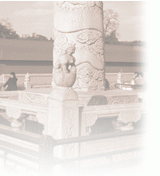| Nanjing Marks 65th Anniversary of Japanese Massacre |
| 2004-06-12 15:28 |
|
A bronze road of footprints from 222 witnesses to the 1937 Nanjing Massacre during which more than 300,000 Chinese were slaughtered by invading Japanese troops, was added to the Nanjing Memorial on Thursday to mark the 65th anniversary of the tragedy. The road, 40 meters long and 1.6 meters wide, is made of bronze blocks cast with the footprints and the handwritten names and agesof those survivors. The number 300,000 is inscribed in black at the end of the road at the memorial's plaza in the capital city of Jiangsu Province, east China. Two bronze sculptures of survivors Peng Yuzhen and Ni Cuiping stand on either side of the road. Ni, four of whose family were killed by Japanese troops, was invited to speak at the launching ceremony. Showing a scar on her left shoulder to the audience she said, "I hate the brutality of Japanese soldiers. Now I hate more those Japanese who deny history." Wu Xiulan, 89, was accompanied by her family to the ceremony. She left only one footprint on the road because she lost her left foot during the massacre. Zhou Wenbin, 65, shared his memory of one of his toes being cut off during the massacre when he was a baby in a cradle. The memorial designers went to Beijing, Shanghai, and Anhui and Jiangsu provinces to collect the footprints and signatures of the 222 witnesses. More than 300,000 unarmed Chinese civilians and soldiers were slaughtered 65 years ago by the Japanese troops, an event right-wing Japanese have repeatedly tried to erase from history. (Xinhua News Agency December 13, 2002) A bronze road of footprints from 222 witnesses to the 1937 Nanjing Massacre during which more than 300,000 Chinese were slaughtered by invading Japanese troops, was added to the Nanjing Memorial on Thursday to mark the 65th anniversary of the tragedy. The road, 40 meters long and 1.6 meters wide, is made of bronze blocks cast with the footprints and the handwritten names and agesof those survivors. The number 300,000 is inscribed in black at the end of the road at the memorial's plaza in the capital city of Jiangsu Province, east China. Two bronze sculptures of survivors Peng Yuzhen and Ni Cuiping stand on either side of the road. Ni, four of whose family were killed by Japanese troops, was invited to speak at the launching ceremony. Showing a scar on her left shoulder to the audience she said, "I hate the brutality of Japanese soldiers. Now I hate more those Japanese who deny history." Wu Xiulan, 89, was accompanied by her family to the ceremony. She left only one footprint on the road because she lost her left foot during the massacre. Zhou Wenbin, 65, shared his memory of one of his toes being cut off during the massacre when he was a baby in a cradle. The memorial designers went to Beijing, Shanghai, and Anhui and Jiangsu provinces to collect the footprints and signatures of the 222 witnesses. More than 300,000 unarmed Chinese civilians and soldiers were slaughtered 65 years ago by the Japanese troops, an event right-wing Japanese have repeatedly tried to erase from history. (Xinhua News Agency December 13, 2002) |
|
||||||||||
 |
||||||||||
|
| ||||||||||
|
| ||||||||||
 | ||||||||||
 | ||||||||||
 |
| Home > News | |
|
|
|